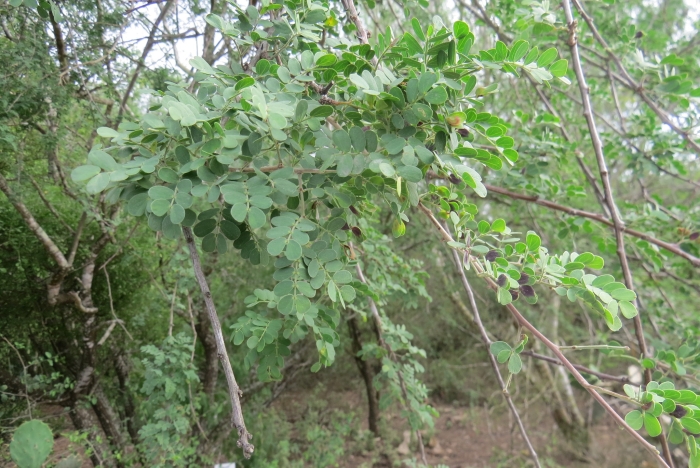Wright’s Acacia
(Senegalia wrightii)
Wright’s Acacia (Senegalia wrightii)
/
/

johnyochum
CC BY 4.0
Image By:
johnyochum
Recorded By:
Copyright:
CC BY 4.0
Copyright Notice:
Photo by: johnyochum | License Type: CC BY 4.0 | License URL: http://creativecommons.org/licenses/by/4.0/ | Rights Holder: johnyochum | Publisher: iNaturalist | Date Created: 2018-04-30T17:44:15-07:00 |












Estimated Native Range
Summary
Senegalia wrightii, commonly known as Wright’s Acacia, is a semi-deciduous shrub or small tree native to arid and semi-arid regions, including desert washes, grasslands, and thorn scrub in Northeast Mexico and Texas. It typically grows to a height of 20-30 feet (6-9 meters) and a width of 15-25 feet (5-8 meters). Wright’s Acacia has a spreading habit with a rounded crown and bears bipinnate, feathery leaves that provide dappled shade. It produces showy clusters of fragrant white to pale yellow flowers in the spring, which are attractive to pollinators such as bees.
Wright’s Acacia is valued for its drought tolerance and ability to thrive in hot, dry climates, making it suitable for xeriscaping and naturalistic plantings. It is also used for erosion control and as a windbreak in suitable regions. In cultivation, it requires full sun exposure and well-drained soils, tolerating a range of soil types from sandy to loamy. While it is low-maintenance and requires minimal supplemental watering once established, it is sensitive to overwatering and poor drainage. This species can be used as a specimen plant or integrated into mixed shrub borders for its textural foliage and floral display.CC BY-SA 4.0
Wright’s Acacia is valued for its drought tolerance and ability to thrive in hot, dry climates, making it suitable for xeriscaping and naturalistic plantings. It is also used for erosion control and as a windbreak in suitable regions. In cultivation, it requires full sun exposure and well-drained soils, tolerating a range of soil types from sandy to loamy. While it is low-maintenance and requires minimal supplemental watering once established, it is sensitive to overwatering and poor drainage. This species can be used as a specimen plant or integrated into mixed shrub borders for its textural foliage and floral display.CC BY-SA 4.0
Plant Description
- Plant Type: Shrub, Tree
- Height: 20-30 feet
- Width: 15-25 feet
- Growth Rate: Moderate
- Flower Color: White, Yellow
- Flowering Season: Spring
- Leaf Retention: Semi-Deciduous
Growth Requirements
- Sun: Full Sun
- Water: Low
- Drainage: Medium
Common Uses
Bee Garden, Butterfly Garden, Drought Tolerant, Low Maintenance, Showy Flowers
Natural Habitat
Native to arid and semi-arid regions, including desert washes, grasslands, and thorn scrub in Northeast Mexico and Texas
Other Names
Common Names: Texas Cat’s-Claw, Tree Cat’s-Claw, Catclaw Acacia, Uña De Gato
Scientific Names: , Senegalia wrightii, Acacia wrightii, Acacia greggii var. wrightii,
GBIF Accepted Name: Senegalia wrightii (Benth.) Britton & Rose